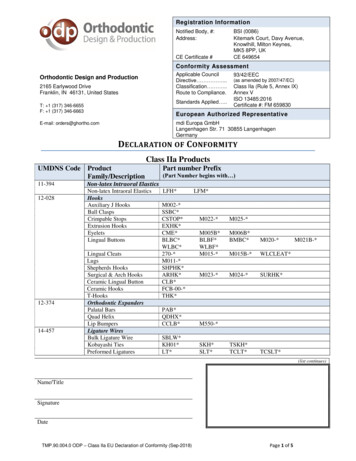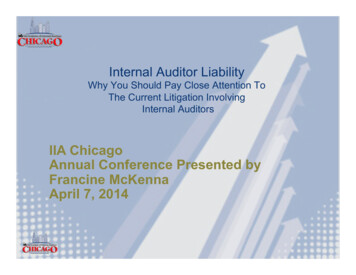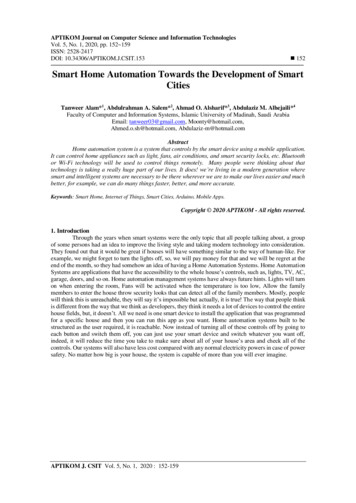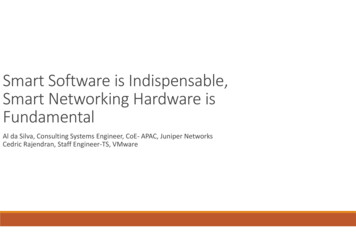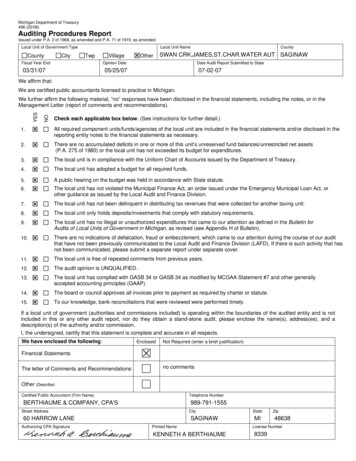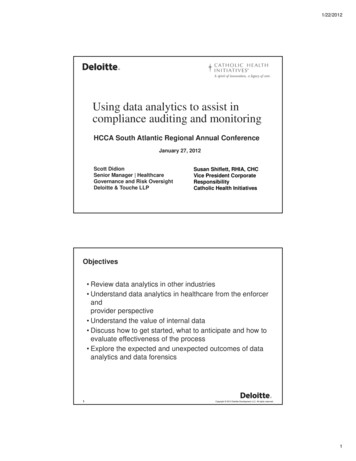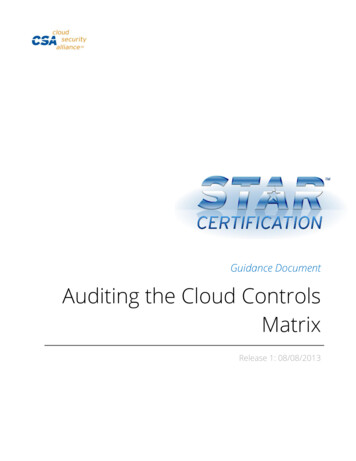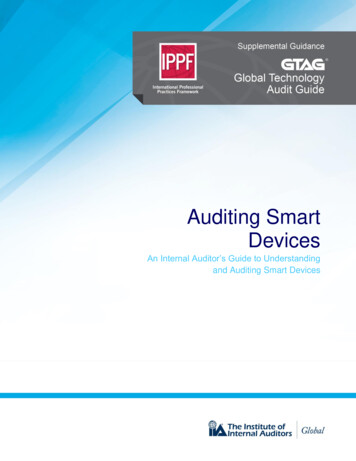
Transcription
Auditing SmartDevicesAn Internal Auditor’s Guide to Understandingand Auditing Smart Devices
GTAG / Auditing Smart DevicesContentsExecutive Summary . 3Introduction . 4Related Risks . 5Compliance Risks . 5Privacy Risks. 5Security Risks . 5Physical Security Risks . 5Information Security Risks . 6Related Controls . 7Smart Device Security Controls . 7IT Policy Control Considerations . 8Smart Device Audit Engagement . 10Engagement Planning . 11Engagement Objective . 11Engagement Scope and Resource Allocation. 11Engagement Work Program . 12Appendix A. Related IIA Standards and Guidance . 13Appendix B. Definitions of Key Concepts . 16Appendix C. Smart Device Audit Program . 18Authors/Contributors . 222
GTAG / Auditing Smart DevicesExecutive SummarySmart devices, such as cell phones and tablets, offer truly mobile and convenient options forworking remotely. Like any new or expanding technology, smart devices also introduceadditional risks for organizations.Internal auditing’s approach to assessing risks and controls related to smart devices isevolving as new technologies emerge and the variety of devices increases. To meet thesechallenges, internal auditors are tasked with: Understanding the organization’s smart device strategy.Evaluating the effect of smart device technology on the organization.Providing assurance over the smart device environment by:o Identifying and assessing risks to the organization arising from the use of suchdevices.o Determining the adequacy of applicable governance, risk management, andcontrols related to such devices.o Reviewing the design and effectiveness of related controls.Chief audit executives (CAEs) should have a thorough understanding of the opportunities andthreats that smart devices present to the organization and the internal audit activity. Theinternal audit activity can support management’s efforts to mitigate risks associated with theuse of smart devices.This guidance should help internal auditors better understand the technology, risks, andcontrols associated with smart devices. Appendix C provides an engagement work program,including a risk assessment, designed specifically to evaluate risk management and controlsrelated to smart devices.3
GTAG / Auditing Smart DevicesIntroductionSmart devices — electronics programmed and controlled through computer technology —have revolutionized the workforce and given new meaning to the concept of the “mobileworker.” Whereas working remotely was once limited to connecting to the organization’snetwork via a laptop provided by the organization, today’s options include phones and tabletsthat utilize specially designed applications (apps) and features to conduct business in a trulymobile way.Smart devices provide organizational users with portable computing power, internetconnectivity wherever there is Wi-Fi or cellular service, and the possibility of having oneconvenient device for personal and business use. Types of smart devices vary widely, as dotheir operating systems, security mechanisms, apps, and networks. Examples includesmartphones, tablets, portable digital assistants (known as PDAs), wearable devices (e.g.,watches and glasses), and handheld gaming devices.Some characteristics associated with smart devices include: Form factor (e.g., tablet, clamshell, wearable).Operating system (e.g., Apple iOS, Android, Windows Mobile, Blackberry OS).Voice and data networking.Video and photograph.Data storage (removable and nonremovable).Global Positioning System (GPS), which enables location services.Consumer and enterprise applications (pre-installed or downloaded).In some organizations, employees may be required to use their own devices to conductbusiness, or they may request to do so, a circumstance known as bring your own device(BYOD). Whether owned by the organization or the employee, smart devices, like any new orexpanding technology, introduce myriad risks that challenge an IT department’s traditionalapproach to risk management.The internal audit activity can support management’s efforts to manage the risks associatedwith the use of smart devices. According to Standard 2120.A1 and Standard 2130.A1, theinternal audit activity must evaluate the risk exposures relating to the organization’sgovernance, operations, and information systems, as well as the adequacy and effectivenessof controls in responding to such risks.1 This GTAG offers a thorough description of the risksrelated to the use of smart devices, the controls that can be used to mitigate those risks to anacceptable level, and an engagement work program that can be used to effectively assess theorganization’s governance, risk management and controls related to smart devices.1Emphasis added. See Appendix A for the complete text of these and other relevant IIA standards.4
GTAG / Auditing Smart DevicesRelated RisksRisks related to smart devices can be categorized as either compliance, privacy, physicalsecurity, or information security.Compliance RisksIn BYOD situations, organizations may rely heavily on users to comply with applicable policiesand procedures, such as guidelines for updating software or operating systems. Users whoconsider updates overly intrusive or degrading to the performance of the device might chooseto bypass controls or not install the updates. A BYOD environment requires the organization’sIT support services to expand its skills and capabilities. Growth in the variety and number ofdevices compounds the organization’s exposure to a range of vulnerabilities. Managing thevarious versions of hardware and software that have the ability to access and hold proprietarydata can be difficult, especially in the absence of prescriptive policies, procedures, andprotocols.Privacy RisksBYOD practices may raise privacy concerns from the perspectives of the organization and theemployee. For example, it may be difficult for an organization to protect a stakeholder’s privacywhen personally identifiable information (PII) is accessed or stored on a smart device, anincreasingly common occurrence. Equally, employees may have privacy concerns that theirsmart device enables intrusive monitoring by the organization or that the organization mightinadvertently wipe, or remove, personal information (e.g., pictures and contact information)from their devices when organizational data is deleted. Additional risk is introduced when thirdparties (e.g., vendors, guests, or visitors) access organizational networks and systems usingtheir own smart devices.Security RisksInformation stored on smart devices may include personal and organizational data. Theinformation may be compromised if the smart device is physically lost or stolen, if the deviceuser leaves the organization without deleting proprietary data from the device, or if appropriatesecurity controls are not in place and operating as intended. Before designing a smart deviceaudit program, auditors should understand the details of several categories of security risks.Physical Security RisksSmart devices are continuously exposed to physical security risks. Due to their mobile nature,smart devices are used in multiple locations and are susceptible to being lost or stolen. Theorganization’s sensitive data may be at risk if the device is used to store or access suchinformation. Organizations should have established protocols for reporting loss or theft and5
GTAG / Auditing Smart Devicesresponding to security incidents; for example, by remotely wiping data stored on smartdevices.Information Security RisksData storage and backupPersonal and organizational data stored on smart devices may be compromised ifappropriate security measures, such as encryption, are not deployed. Recovery of data fromdevice or system failure also may be a concern if devices are not backed up properly.Operating systemsEach of the various smart device operating systems (OSs) presents unique security featuresand risks that may need to be managed, configured, and secured differently. When usersbypass OS administrative restrictions through the processes of jailbreaking (Apple OS) orrooting (Android OS), factory-installed security controls are disabled and additional securityvulnerabilities may be introduced. Additionally, the variation in platforms makes it morecomplicated for organizations to wipe data when an employee replaces a device or changesservice providers.Network connectionsSmart devices connect to the internet via wireless or cellular networks, which may beuntrusted. Untrusted networks (e.g., unsecure wireless networks or Bluetooth) aresusceptible to various security risks that could compromise data in transit, such as sessionhijacking (an exploitation of a valid network session for unauthorized purposes),eavesdropping, and man-in-the-middle attacks (an attack strategy in which the attackerintercepts the communication stream between two parts of the victim’s system and thenreplaces the traffic between the two components with the intruder’s own, eventuallyassuming control of the communication).ApplicationsAn extensive number and variety of apps available from mobile app stores can bedownloaded directly to the smart device. These apps are generally developed by third-partyvendors, ranging from large software development companies to individuals working fromtheir homes. Viruses, Trojan horses, and other malware may infect the smart device if mobiledevice platforms and app stores do not place security restrictions or other limitations on thirdparty app publishing.6
GTAG / Auditing Smart DevicesLocationA GPS, which enables location services, could be used to track smart devices, monitor userbehavior, and plan cyberattacks. The location and personal characteristics of an individualcan potentially be determined by comparing data from various sources such as social media,web browsers, and navigation apps. Additional location leaks can occur from GPSembedded photos.Related ControlsSmart Device Security ControlsSmart devices offer a number of security features that organizations can use to reduce risks.Authentication ‒ Authentication, the first step in securing a smart device, preventsunauthorized users from accessing the device’s apps and data. Smart devices typically employone or more of the following authentication methods: passcode, swipe pattern, biometrics,security questions, or a personal identification number (PIN). A PIN is a numeric code, thesimplest form of authentication. A passcode uses a combination of numbers, letters, and othersymbols. Another authentication method is the swipe pattern, which requires the user to swipea chosen matrix of dots on the initial screen. Finally, security questions require users to answerone or more preset personal security questions. These methods are subject to user discretion;the user chooses the code or pattern.To mitigate the risk that users will select weak PINs or passcodes, an organization’s ITfunction can enforce strong parameters through mobile device management (MDM) softwareor require a second authentication to access the organization’s apps. Security questions areoften used for secondary authentication in smart devices (e.g., when the user forgets thepasscode, the security questions option can be used to authenticate). Perhaps the mostsecure authentication method is biometrics, the use of technology such as facial recognitionand fingerprint readers.Remote Wipe ‒ Remote wipe is the ability of the user or an IT administrator to wipe data andapplications via the network, without having physical possession of the device. Remote wipecan also restore default settings and lock encrypted data from further access. For organizationowned smart devices, IT administrators should deploy MDM software or an alternative
GTAG / Auditing Smart Devices Introduction Smart devices — electronics programmed and controlled through computer technology — have revolutionized the workforce and given new meaning to the concept of the “mobile worker.” Whereas working remotely was once limited to
